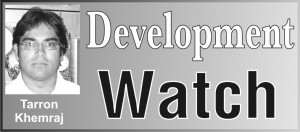Part 2
Introduction
As noted in the previous article, the purpose of this series of columns is to explain why widespread contagion in the Guyana financial system did not follow the global financial crisis, which was precipitated by the US subprime meltdown. The World Bank and IDB noted, without much empirical evidence, that Guyana would have been adversely affected by a slowdown of remittance inflows. The task of this essay is to go beyond the slowdown of remittances. I am more interested in understanding why there was not a systemic meltdown of the Guyanese financial system while the world was shaken by financial turmoil.
 In order to understand why Guyana was largely unaffected by the global financial crisis, I noted in the previous column we first need to examine what occurred in the United States. This will allow readers to gauge the different financial structures that prevailed in the US that make that country susceptible to financial panic. Once we look at the characteristics of US finance we will see that Guyana is vastly different and that some of these differences, boring as they might seem, fortuitously saved us from a systemic crisis.
In order to understand why Guyana was largely unaffected by the global financial crisis, I noted in the previous column we first need to examine what occurred in the United States. This will allow readers to gauge the different financial structures that prevailed in the US that make that country susceptible to financial panic. Once we look at the characteristics of US finance we will see that Guyana is vastly different and that some of these differences, boring as they might seem, fortuitously saved us from a systemic crisis.
Other Factors in the US Meltdown

Following a financial sector lobbying blitz of at least US$250M, US lawmakers repealed the Glass-Steagall Act in 1999. This Act was passed in 1933 as a means of distinguishing between investment and commercial banks. Commercial banks accept a nation’s savings and channel them into profitable investments. Investment banks underwrite (to organize the sale of) stocks and bonds and engineer new financial instruments such as those I explained in the previous column. The intention of the 1933 Glass-Steagall Act was to make these two forms of banking distinguishable. It was believed that investment banking is more risky and therefore the nation’s deposits should not be directed to these activities. Furthermore, if investment and commercial banks are not different then the latter might want to bail out the risky underwritings of the former. The 1933 Act, therefore, was meant to remove this potential conflict of interest.
Dismantling the Act opened the gate for universal banking where a bank can pursue both investment and commercial banking services. This occurred during a time of deregulation and tremendous faith in markets as agents of self-regulation. Universal banks also became highly integrated in financial markets – money and capital markets alike. One way this deep integration with markets occurred was through proprietary trading desks.
Here banks established special desks with traders who trade and speculate in stocks, bonds, commodities and derivatives. The banks use their own capital rather than the monies of the public to invest/speculate in these assets. With this, development banks are not only entities of financial intermediation (the traditional function), but also traders and agents of speculation. Proprietary trading results in volatile profit making and contribute to volatile financial asset and commodity prices (such as gold, copper, oil, sugar, natural gas, etc). Although these entities are purported to use only their own capital, the risky trading was at the heart of the meltdown because as financial asset prices crashed within hours, the capital base of banks was wiped out; hence, the need for government bailout using taxpayers’ monies.
Repealing the Act also opened the door for banks to establish off-balance-sheet entities known as special investment vehicles (SIVs). The SIVs allowed banks to circumvent minimum capital requirements (money owners or shareholders of banks must hold as a buffer against unforeseen adverse events) enshrined in the Basel rules. As the SIVs were off-balance-sheet entities, there was no need to hold capital against bank liabilities.
In other words, the SIVs allowed banks to take on more risks with the same amount of capital. The SIVs raised funds by issuing commercial papers (a short-term financial instrument of the money market) and invest them in long-term securities such as CDOs in the capital market. This situation of borrowing short and investing in long long-term assets would result in financing troubles for the banks. And even though they were supposed to be off-balance-sheet, when the crisis hit, banks were forced to bail out their SIVs. Therefore entities. Just the exact kind of occurrence Glass-Steagall was meant to prevent.
The link of banks with financial markets was made even stronger in April 2004 when the Securities and Exchange Commission (SEC) – an agency of government mandated to regulate – relaxed the debt-to-capital ratio of the largest investment banks from 12:1 to 30:1 and greater. The implication is if a bank has capital of US$1 billion after April 2004 it could borrow US$30 billion (and above) instead of the previous US$12 billion. This policy change, therefore, allowed the banks to take on more debt or leverage. As explained above with respect to the SIVs, the new debt was used to invest in newly created financial instruments like CDOs, mortgage-backed securities and other asset-backed securities. Embedded in the mortgage-backed securities and CDOs is the debt held by sub-prime borrowers. The financial time bomb was firmly planted.
It turns out that leverage and rapid asset price adjustments would be at the core of the meltdown. Leverage occurs when banks borrow money to make investments in financial assets, thus boosting profits when times are good. Let us use a simple numerical example. If you invest $10 at 10% interest you earn $1 profit. However, if you borrow $90 and invest it along with your $10 you now make $10 profit. On the other hand, leverage can cause banks to lose all capital in a matter of hours when asset prices collapse as occurred during the panic of 2007-08. A 10% loss on your capital of $10 still leaves you with $9. However, a 10% loss on the $90 borrowed funds plus your capital of $10 wipes out your entire capital base. In this case, the net worth of the bank has disappeared and it is insolvent. This was the situation that prevailed during the panic period as the price of many financial assets crashed. Assets crashed but debt remained on the books for many. Therefore, the government – whose intervention was seen as harmful to markets before the crisis – was suddenly seen as the saviour. The Troubled Asset Relief Program (TARP) was engineered by the US Treasury to bail out the champions of free market capitalism.
Conclusion
I will conclude this essay by noting the crucial components of financial contagion and panic. First, there was an accumulation of excessive debt as was emphasized long ago by Hyman Minsky. More and more the loans were made to risky subprime borrowers (those with a higher likelihood to default). It was believed that risk management methods (mathematical models such as value at risk, VaR, and new financial instruments like derivatives) would spread these risks around and even mitigate some of the risks. Second, asset prices are flexible, volatile and traded in markets that are susceptible, at times, to herd behaviour, irrational sentiments and limited information.
Third, debt remained on the books of banks even after assets crashed. This latter point is quite prominent in the US beyond the financial markets, which seemed to have recovered (unlike employment). Take for example the housing market. While house prices (assets) have crashed, the mortgages (liabilities) have not adjusted accordingly. Thus millions of American households own homes that are worth less than the mortgage they owe the banks. Their equity is negative; hence one reason for the lingering pessimism among consumers. The recent refinancing boom, owing to the very low mortgage interest rate, is just not enough to correct this situation.
Fourth, there was a sustained period of easy monetary policy (low interest rate and readily available cash) where universal banks found it easy to fund speculative activities, including expanding lending into the risky sub-prime categories. Fifth, deregulation and the refusal to enforce regulation with existing rules fuelled the housing bubble. Sixth, the rating agencies gave the new risky asset-backed securities (and collateralized debt obligations, CDOs) artificially high credit ratings
.
In the next column I will explain why Guyana dodged the financial crisis.
Please send comments and criticisms to: tarronkhemraj@gmail.com




